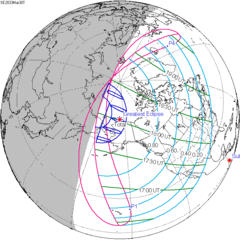March 2024 lunar eclipse
| Penumbral eclipse | |||||||||
 From Richmond, Virginia, 7:18 UTC | |||||||||
| Date | March 25, 2024 | ||||||||
|---|---|---|---|---|---|---|---|---|---|
| Gamma | 1.0609 | ||||||||
| Magnitude | −0.1304 | ||||||||
| Saros cycle | 113 (64 of 71) | ||||||||
| Penumbral | 279 minutes, 9 seconds | ||||||||
| |||||||||
A penumbral lunar eclipse occurred at the Moon’s descending node of orbit on Monday, March 25, 2024,[1] with an umbral magnitude of −0.1304. A lunar eclipse occurs when the Moon moves into the Earth's shadow, causing the Moon to be darkened. A penumbral lunar eclipse occurs when part or all of the Moon's near side passes into the Earth's penumbra. Unlike a solar eclipse, which can only be viewed from a relatively small area of the world, a lunar eclipse may be viewed from anywhere on the night side of Earth. Occurring about 2.2 days after apogee (on March 23, 2024, at 11:45 UTC), the Moon's apparent diameter was smaller.[2]
This was the deepest penumbral eclipse overall since May 5, 2023, and the deepest for North and South America since February 11, 2017.[3]
Visibility
[edit]The eclipse was completely visible over North and South America, seen rising over eastern Australia and northeast Asia and setting over west Africa and western Europe.[4]
 
|
Eclipse details
[edit]Shown below is a table displaying details about this particular solar eclipse. It describes various parameters pertaining to this eclipse.[5]
| Parameter | Value |
|---|---|
| Penumbral Magnitude | 0.95767 |
| Umbral Magnitude | −0.13044 |
| Gamma | 1.06098 |
| Sun Right Ascension | 00h18m49.9s |
| Sun Declination | +02°02'16.6" |
| Sun Semi-Diameter | 16'02.2" |
| Sun Equatorial Horizontal Parallax | 08.8" |
| Moon Right Ascension | 12h20m41.3s |
| Moon Declination | -01°12'05.6" |
| Moon Semi-Diameter | 14'44.3" |
| Moon Equatorial Horizontal Parallax | 0°54'05.4" |
| ΔT | 71.2 s |
Eclipse season
[edit]This eclipse is part of an eclipse season, a period, roughly every six months, when eclipses occur. Only two (or occasionally three) eclipse seasons occur each year, and each season lasts about 35 days and repeats just short of six months (173 days) later; thus two full eclipse seasons always occur each year. Either two or three eclipses happen each eclipse season. In the sequence below, each eclipse is separated by a fortnight.
| March 25 Descending node (full moon) |
April 8 Ascending node (new moon) |
|---|---|
 |

|
| Penumbral lunar eclipse Lunar Saros 113 |
Total solar eclipse Solar Saros 139 |
Related eclipses
[edit]Eclipses in 2024
[edit]- A penumbral lunar eclipse on March 25.
- A total solar eclipse on April 8.
- A partial lunar eclipse on September 18.
- An annular solar eclipse on October 2.
Metonic
[edit]- Preceded by: Lunar eclipse of June 5, 2020
- Followed by: Lunar eclipse of January 12, 2028
Tzolkinex
[edit]- Preceded by: Lunar eclipse of February 11, 2017
- Followed by: Lunar eclipse of May 7, 2031
Half-Saros
[edit]- Preceded by: Solar eclipse of March 20, 2015
- Followed by: Solar eclipse of March 30, 2033
Tritos
[edit]- Preceded by: Lunar eclipse of April 25, 2013
- Followed by: Lunar eclipse of February 22, 2035
Lunar Saros 113
[edit]- Preceded by: Lunar eclipse of March 14, 2006
- Followed by: Lunar eclipse of April 5, 2042
Inex
[edit]- Preceded by: Lunar eclipse of April 15, 1995
- Followed by: Lunar eclipse of March 4, 2053
Triad
[edit]- Preceded by: Lunar eclipse of May 25, 1937
- Followed by: Lunar eclipse of January 25, 2111
Lunar eclipses of 2024–2027
[edit]| Lunar eclipse series sets from 2024–2027 | ||||||||
|---|---|---|---|---|---|---|---|---|
| Descending node | Ascending node | |||||||
| Saros | Date | Type Viewing |
Gamma | Saros | Date Viewing |
Type Chart |
Gamma | |
113
|
2024 Mar 25
|
Penumbral
|
1.06098 | 118
|
2024 Sep 18
|
Partial
|
−0.97920 | |
| 123 | 2025 Mar 14
|
Total
|
0.34846 | 128 | 2025 Sep 07
|
Total
|
−0.27521 | |
| 133 | 2026 Mar 03
|
Total
|
−0.37651 | 138 | 2026 Aug 28
|
Partial
|
0.49644 | |
| 143 | 2027 Feb 20
|
Penumbral
|
−1.04803 | 148 | 2027 Aug 17
|
Penumbral
|
1.27974 | |
| Last set | 2023 May 05 | Last set | 2023 Oct 28 | |||||
| Next set | 2028 Jan 12 | Next set | 2027 Jul 18 | |||||
Saros 113
[edit]It is part of Saros cycle 113.
Half-Saros cycle
[edit]A lunar eclipse will be preceded and followed by solar eclipses by 9 years and 5.5 days (a half saros).[6] This lunar eclipse is related to two total solar eclipses of Solar Saros 120.
| March 20, 2015 | March 30, 2033 |
|---|---|

|

|
See also
[edit]References
[edit]- ^ "March 24–25, 2024 Penumbral Lunar Eclipse". timeanddate. Retrieved 18 November 2024.
- ^ "Moon Distances for London, United Kingdom, England". timeanddate. Retrieved 18 November 2024.
- ^ Hermit Eclipse: Saros cycle 113
- ^ "Penumbral Lunar Eclipse of 2024 Mar 25" (PDF). NASA. Retrieved 18 November 2024.
- ^ "Penumbral Lunar Eclipse of 2024 Mar 25". EclipseWise.com. Retrieved 18 November 2024.
- ^ Mathematical Astronomy Morsels, Jean Meeus, p.110, Chapter 18, The half-saros
External links
[edit]- Saros cycle 113
- 2024 Mar 25 chart: Eclipse Predictions by Fred Espenak, NASA/GSFC



